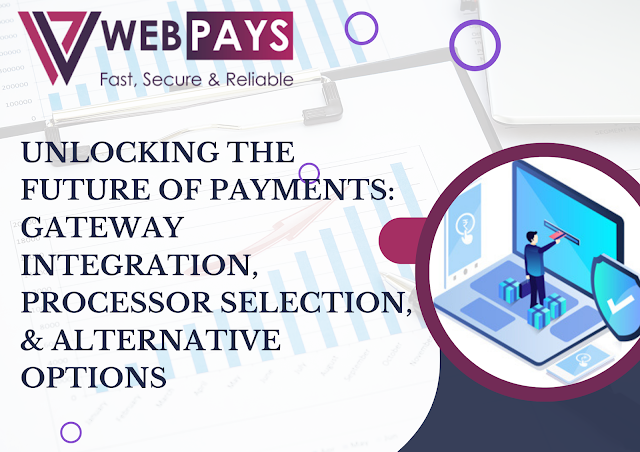Unlocking the Future of Payments: Gateway Integration, Processor Selection, & Alternative Options


In a world where businesses lose $200,000 every second to
cyber crimes and where fraud growth percentages are higher than business growth
percentages, businesses need to acquire high risk
payment processing services to secure themselves from potential fraud.
These services are specially crafted for industries that are more prone to
fraud and chargebacks and are considered high-risk by banks and traditional
payment processors. In this blog post, we will learn about these specialized
services, including high-risk merchant accounts and high-risk business payment
gateways, and we will also comprehend how they safeguard businesses from cyber
attacks.
A high risk business payment gateway is a secure bridge
between your business's high-risk merchant account and your customer's account.
It secures the payment details before transmitting them between the involved
parties, including the payment processor, card company, acquiring bank, and
issuing bank. Basically, it acts as a postman, transferring letters
(information) from origin to destination. It allows businesses to accept
payments in multiple currencies and alternative payment methods from
international customers. It also keeps track of transactions. Moreover, a
payment gateway performs many tasks to transfer funds from customers to
merchants safely.
High-risk business payment
gateways are designed to safeguard businesses from cyberattacks by implementing
a range of security measures and best practices. These gateways cater to
industries and businesses that are more susceptible to fraud or face regulatory
challenges, such as online gaming, gambling, adult entertainment, forex trading,
CBD, or high-value e-commerce. Here are some ways in which high risk merchant
account and payment gateways help protect businesses:
High-risk payment gateways employ
sophisticated fraud detection systems that use machine learning and artificial
intelligence to analyze transactions in real-time. They can identify unusual or
suspicious patterns and flag potentially fraudulent transactions for further
review.
All data transmitted through the
payment gateway is encrypted using industry-standard protocols like SSL (Secure
Sockets Layer) or TLS (Transport Layer Security). This encryption ensures that
sensitive information, such as credit card numbers and personal data, is
protected during transmission.
High-risk business payment
gateways use tokenization to replace
sensitive cardholder data with a unique token. This token can be used for
payment processing without exposing the actual card details. Even if a
cyberattacker gains access to the tokens, they are useless without the
corresponding decryption keys.
Payment Card Industry Data
Security Standard (PCI DSS) compliance is crucial for any payment gateway.
High-risk gateways often have strict PCI DSS compliance measures in place to
ensure that they meet industry standards for data security.
Implementing multi-factor
authentication (MFA) adds an extra layer of security. High-risk payment
gateways may require customers to provide additional authentication factors
beyond a password, such as a one-time code sent to their mobile device.
Velocity checks monitor the
frequency and volume of transactions to detect potential fraud. If a high
number of transactions occur in a short period, the system may flag them for
review.
These gateways can analyze the
geographic location and IP addresses associated with transactions. Suspicious
deviations from normal customer behavior can trigger alerts.
High-risk payment gateways often
maintain lists of known fraudulent accounts, compromised credit card numbers,
and high-risk countries. Transactions involving these elements can be flagged
for review or declined.
Businesses using high-risk payment
gateways can set their own rules and thresholds for transaction approval. This
flexibility allows them to adapt to changing risk levels.
Many high-risk payment gateways
provide round-the-clock monitoring and support to respond quickly to any
security incidents or suspicious activities.
It's important to note that while high risk payment
gateway offer enhanced security measures, businesses must also take
responsibility for their own cybersecurity. This includes keeping software and
systems up to date, training employees on security best practices, and
regularly reviewing and adjusting their security policies and procedures.
In conclusion, as businesses navigate the treacherous waters
of the digital age, protecting themselves from cyber threats and fraud becomes
paramount. High-risk payment processing services, including specialized
merchant accounts and payment gateways, offer a lifeline for industries
susceptible to fraud and chargebacks. These services act as the vigilant
guardians of financial transactions, employing advanced security measures to
fortify the digital armor of businesses. They incorporate cutting-edge fraud
detection, robust encryption, and compliance with industry standards such as
PCI DSS. Additionally, features like tokenization, multi-factor authentication,
and geolocation analysis add layers of defense against cyber threats.
Customizable rules and round-the-clock monitoring ensure adaptability and swift
response to emerging risks.
In this ever-evolving landscape of cybercrime, acquiring a
high-risk payment processing partner like WebPays can be the shield that your
business needs. With their expertise and commitment to security, they offer a
reliable defense against the relentless tide of cyber threats, allowing
businesses to thrive in an era of digital commerce. Don't wait until the next
cyberattack; fortify your business today with WebPays' high-risk business
payment gateway solutions. Apply Now
Comments
Post a Comment